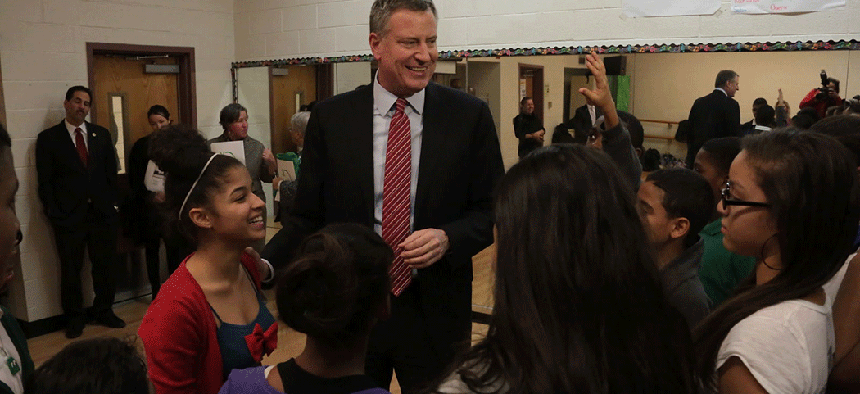New York City
Losing mayoral control of NYC schools would be a step backward
For the past 17 years, since mayoral control of New York City schools was enacted innovation has increased and outcomes have improved. To undo that would make schools less accountable.

Mayor Bill de Blasio visits the Bronx School of Young Leaders after-school program. NYC Mayor's Office/Flickr
The New York City public school system that existed when I started my career as a middle school teacher in Harlem over 25 years ago would be nearly unrecognizable today.
High schools were run by the Board of Education’s seven members, two of whom were appointed by the mayor, the remaining five by the borough presidents. Community boards ran the city’s elementary and middle schools. Day-to-day, it wasn’t clear who was responsible for schools. The system was rife with patronage and corruption, and easily gamed by well-connected parents and officials. It sounds incredible that jobs were handed out as favors, but in the absence of strong, centralized oversight, in some districtsprincipal and assistant principal appointments could literally be bought.
But this is what it was. And while some adults profited, children paid the ultimate price.One out of every two students who set foot in city schools around this time left their high schools without ever obtaining a diploma. Entire districts lacked experienced teachers and basic school supplies. And, above all, no one was held accountable for these injustices.
That changed in 2002, when the state Legislature gave then-New York City Mayor Michael Bloomberg control of the city’s schools and, with it, accountability. Since New York City embarked on that experiment, it has demonstrated that direct mayoral control encourages pedagogical innovation and fosters school improvement. To undo this would be to reduce democratic accountability and rob New York City's public schoolchildren of opportunities. To go backwards would slide the entire school system into the old, decentralized structure, and school boards and chaos would once again reign.
By every measure, the city’s students have made phenomenal gains during the last 17 years under mayoral control.Graduation rates are at all-time highs,dropout rates are at all-time lows,more city kids are going to and succeeding in college, andschools have built stronger relationships with the families and communities they serve.
These are only a few pieces of evidence that mayoral control works. The past 17 years have also brought hundreds of innovative new schools and pioneering early education initiatives that are transforming the futures of tens of thousands of children, including universal pre-K and 3-K. Mayoral control has demonstrated that when clear and accountable leadership for the school system is in place, profound change can happen.
These and the other meaningful gains we have seen in city schools over the past several years were only possible because of mayoral control. A system this large is very hard to change – improvements come slowly even when the direction is clear. Before mayoral control, even smart, well-intentioned efforts to improve New York City public schools largely failed. This failure was a function of a fragmented governance process where it was impossible to act decisively on behalf of children.
Mayoral control still puts power in the hands of parents and communities. New Yorkers wield ultimate say on educational policy and the direction of schools, because their vote every four years for mayor determines who should lead the way, based on the values, vision and skill of that leader.
Today schools across the city are seeing important gains, but we still have a lot of work ahead to create a system of great schools where equity is real, each child is known well, and engaging hands-on academic work consistently pushes our students to reach their full potential.
After more than two decades of experience in New York City schools – including five years as deputy chancellor under Mayor Bloomberg – it is clear to me that if we want to reach that goal, we will need bold and sometimes controversial leadership from the New York City Department of Education. Extending mayoral control is a precondition for that leadership, and meaningful change for the city’s children.
I urge our state legislators to renew mayoral control today.
NEXT STORY: Replace JCOPE with an independent body

